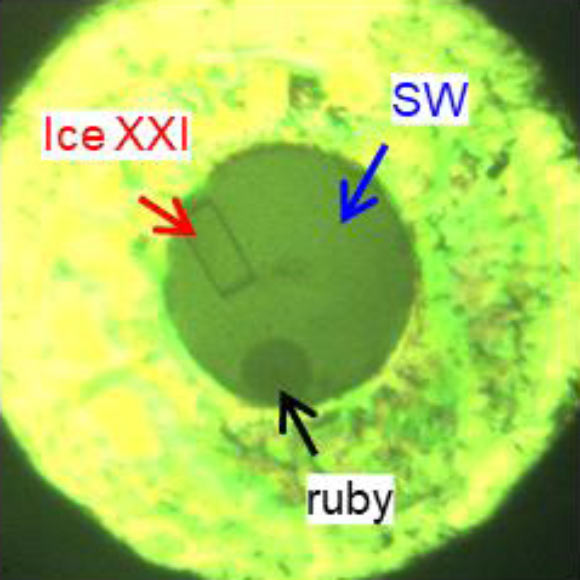Scientists have demonstrated that supercompressed water transforms into ice VI at room temperature through multiple freezing-melting pathways, which occur via a previously unknown form of metastable ice, named ice XXI.

A small crystal of ice XXI formed through nucleation and slow melting process. Image credit: Lee et al., doi: 10.1038/s41563-025-02364-x.
Water, composed of only two elements, forms numerous polymorphic phases from ice Ih to ice XX and four amorphous phases.
Understanding the formation and transition pathways of the diverse water phases has been of interest in high-pressure physics and the search for life in space and on icy moons for a century.
“Water exhibits remarkable complexity in its solid state,” said Dr. Geun Woo Lee, a researcher at the Korea Research Institute of Standards and Science and the University of Science and Technology.
“The majority of the phases are observed at high pressures and low temperatures.”
“Rapid compression of water allows it to remain liquid up to higher pressures, where it should have already crystallized to ice VI.”
“Ice VI is an especially intriguing phase, thought to be present in the interior of icy moons such as Titan and Ganymede.”
“Its highly distorted structure may allow complex transition pathways that lead to metastable ice phases.”
“Because most ice variants exist only under extreme conditions, we created high pressure conditions using diamond anvil cells.”
“The sample — in this case water — is placed between two diamonds, which can be used to build up very high pressure due to their hardness.”
“Water was examined under pressures of up to two gigapascals, which is about 20,000 times more than normal air pressure.”
“This causes ice to form even at room temperature, but the molecules are much more tightly packed than in normal ice.”
In order to observe ice formation under different pressure conditions, the researchers first generated a high pressure of two gigapascals within 10 milliseconds.
They then released the anvil cell over a period of 1 second, then repeated the process.
During these cycles, the scientists used the X-ray flashes of the European XFEL to capture images of the sample every microsecond.
With its extremely high rate of X-ray pulses, they could make movies of how the ice structure formed.
Then, using the P02.2 beamline at PETRA III, the authors determined that ice XXI has a tetragonal crystal structure built of surprisingly large repetitive units, called unit cells.
“With the unique X-ray pulses of the European XFEL, we have uncovered multiple crystallization pathways in water which was rapidly compressed and decompressed over 1,000 times using a dynamic diamond anvil cell,” Dr. Lee said.
“In this special pressure cell, samples are squeezed between the tips of two opposing diamond anvils and can be compressed along a predefined pressure pathway,” said Dr. Cornelius Strohm, a researcher at the Deutsches Elektronen-Synchrotron.
“The structure in which liquid water crystallizes depends on the degree of supercompression of the liquid,” Dr. Lee said.
“Our findings suggest that a greater number of high temperature metastable ice phases and their associated transition pathways may exist, potentially offering new insights into the composition of icy moons,” said Dr. Rachel Husband, also from the Deutsches Elektronen-Synchrotron.
The findings were published October 10 in the journal Nature Materials.
_____
YH. Lee et al. Multiple freezing-melting pathways of high-density ice through ice XXI phase at room temperature. Nat. Mater, published online October 10, 2025; doi: 10.1038/s41563-025-02364-x







